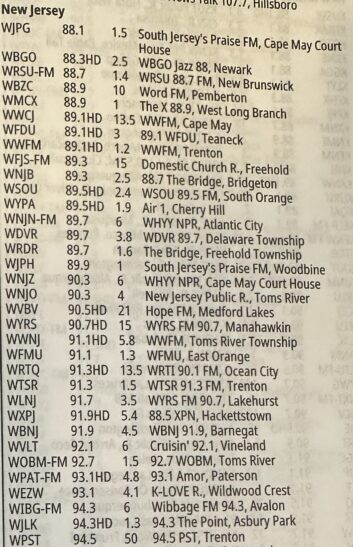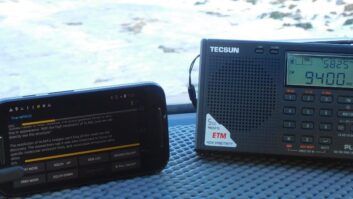
Nick’s Signal Spot is a new feature in which Nick Langan explores RF signals, propagation, new equipment or related endeavors.
The World Radio TV Handbook has reached its 79th volume, available in paperback, ebook and web app formats.
The guide is a celebration of everything its publisher, Radio Data Center, has to offer.
This is the third edition produced by the German company founded by Günter Lorenz. RDC’s large database of worldwide stations supplies several different automotive infotainment systems. The company also maintains partnerships with academic institutions.
Lorenz himself is a radio hobbyist, the founder of a website that fuels distant radio listening efforts worldwide, FMList. Other branches of RDC’s offerings include the fmstream.org Radio Stream Directory, which contains a comprehensive list of streams for stations around the world.
Put it all together and his venture already amassed a premiere collection of radio-related data.
But as Radio World noted last year, Lorenz and RDC saw an opportunity to jump in when WRTH’s original publisher announced the 2022 edition would be its last.
For the upcoming FM DX season, I plan to keep my copy close by at all times and I give the World Radio TV Handbook my hearty endorsement.
What’s new for 2025?
This year’s version features data from 255 countries, with reviews and articles. There are background stories from Barbados, Liberia and Uganda.
Lorenz and RDC CEO Oliver Schmidt hosted a live Q&A launch call for the WRTH in January where they reflected on the large effort to put the guide together. Schmidt explained the guide has contributors and team members worldwide.
“It’s a job we do every day, not just once a year,” Schmidt said.
There’s still nothing like the paperback copy. It comes in at exactly 800 pages, despite a remarkable amount of data. In the launch call, Lorenz and Schmidt note they removed a redundant North American frequency list to keep the page count in order.
The print version, of course, is a static moment in time. As such, both the ebook and web app are available with real-time broadcast schedules and a search feature. The digital versions include a May update with a summer program schedule update for HF listings.
There’s also more comprehensive TV listings this year. The book is named WRTH, as Schmidt pointed out in the Q&A — the “T” stands for television. “We are committed to covering it more completely,” he said.
For the U.S., these are categorized by network affiliation. They are also available in descending order by channel for major TV markets, with channel, transmitter output, state, city of license and callsign.
Hardware and software reviews
Schmidt also provides an overview of current SDR hardware and software offerings, with an easy-to-follow table categorized by user experience, receiver compatibility and reception results.
For those readers seeking more tried and true receivers you can touch, there’s a trademark HF receiver guide, with ratings of offerings from Icom, Sangean and Tescun.
There’s also a full profile of the fmdx.org project, where founders Marek Farkaš and Sjef Verhoeven have taken the TEF6686 receiver to new heights, including with innovations such as the FM DX Webserver. There are now 288 webservers online worldwide where you can listen to the FM stations heard at each location.

FMList has partnered with fmdx.org for a direct interface into the webserver software, including for real-time DX loggings via RDS PI code. FMList maintains PI code associations with radio stations in its database.
Comprehensive listings
But what you really came here for are the station listings. This is where RDC’s data has made the WRTH all the more valuable.
There’s a country-by-country breakdown of AM, FM and applicable DAB stations, complete with call sign, frequency, ERP and slogan, along with, in the U.S., indicators of whether a station broadcasts in HD Radio, when known.
U.S. listings are broken down into states and they are comprehensive, with all full-power stations included in RDC’s data at the time of 2025 publication — it does not include translators.

The guide’s international radio listings list all shortwave broadcasters, with known winter 2024/2025 schedules.
As mentioned, you’ll want to consult the online version of the WRTH with up-to-date frequency and time schedules for the HF broadcasters.
Shortwave and medium wave stations are also indexed by frequency.
The evolution of long-distance listening

In the 79th guide’s editor’s note, Lorenz and Schmidt acknowledge that the book’s purpose is to aid listeners in their experience of the world through the audio broadcast medium.
“Radio is an ideal tool for discovering what’s happening beyond your local horizon,” Lorenz and Schmidt wrote.
They note, however, that some modern technological advances have had drawbacks for radio reception.
“From switched power supplies to TV sets, computer screens and photovoltaic installations, these sources of interference can all be ‘heard’ on the radio, with no way to eliminate the noise,” they wrote.

Nevertheless, the WRTH continues to adapt. Schmidt authored a page dedicated to setup of a remote receiver, ideally placed at a location devoid of such noise. The fmdx.org webservers that FMList helps fuel are examples of what is now possible.
A worthy addition to your listening post
The paperback goes for about $52 USD currently on Amazon. If you purchase the paperback, an upgrade to the web app is just $10 USD.
Next year will mark the 80th edition. To reinforce its presence, RDC’s WRTH team is hosting recurring YouTube live streams — called Radio Unplugged. The latest episode profiles DX’ing across South America.
“Our mission is to be the bible for radio listeners worldwide — whether you produce or listen,” Lorenz said.
[Read the Signal Spot from Nick Langan for More DX-Related Stories]







